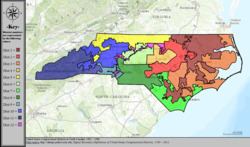Date decided 1993 | ||
 | ||
Full case name Ruth O. Shaw, et al., Appellants v. Janet Reno, Attorney General et al. Citations 509 U.S. 630 (more)
113 S. Ct. 2816; 125 L. Ed. 2d 511; 61 U.S.L.W. 4818; 1993 U.S. LEXIS 4406 Prior history Appeal from the United States District Court for the Eastern District of North Carolina, 808 F.Supp. 461 Subsequent history 808 F.Supp. 461, reversed and remanded. Majority O'Connor, joined by Rehnquist, Scalia, Kennedy, Thomas Dissent White, joined by Blackmun, Stevens Ruling court Supreme Court of the United States Similar Miller v Johnson, Baker v Carr, Wesberry v Sanders, Reynolds v Sims, Adarand Constructors - Inc v Peña | ||
Shaw v reno
Shaw v. Reno, 509 U.S. 630 (1993), was a United States Supreme Court case argued on April 20, 1993. The ruling was significant in the area of redistricting and racial gerrymandering. The court ruled in a 5-4 decision that redistricting based on race must be held to a standard of strict scrutiny under the equal protection clause. On the other hand, bodies doing redistricting must be conscious of race to the extent that they must ensure compliance with the Voting Rights Act of 1965. The redistricting that occurred after the 2000 census, as required to reflect population changes, was the first nationwide redistricting to apply the results of Shaw v. Reno.
Contents
Factual background and majority opinion
The case involved the redistricting of North Carolina after the 1990 census. North Carolina submitted to the Department of Justice a map with one majority-minority black district—that is, a district with a black majority. The Department of Justice believed that the state could have drawn another such majority-minority district in order to improve representation of black voters rather than including them all within one district. The state revised its map and submitted a new plan, this one with two majority-minority districts. The proposed 12th district was 160 miles (260 km) long, winding through the state to connect various areas having in common only a large black population. A federal District Court dismissed a lawsuit by some North Carolina voters on the grounds that they had no claim for relief under a standard set by a previous Supreme Court case, United Jewish Organizations of Williamsburgh v. Carey.
Justice Sandra Day O'Connor delivered the opinion of the Court, which reversed that of the District Court. She described the shape of the new district as "bizarre" and said such a district "bears an uncomfortable resemblance to political apartheid." The Court found that if a redistricting map is "so bizarre on its face that it is 'unexplainable on grounds other than race'," that a claim for relief under the Fourteenth Amendment to the United States Constitution is available to plaintiffs. Such redistricting will be held unconstitutional if it is found to be intended to segregate voters by race and this segregation cannot be justified under a standard of strict scrutiny. Actions subject to this standard must satisfy three conditions: a compelling government interest, narrowly tailored to achieve that goal, and the least restrictive means for achieving that interest.
Dissents
The dissenters noted:
(1) that the case was brought by white voters challenging the district. Its boundaries had enabled the district's majority of black voters to elect the majority-white state's first black representatives to Congress since 1898, when George Henry White was re-elected to his second term in Congress from North Carolina's 2nd congressional district. (In 1899, after North Carolina Democrats passed a new state constitution to disfranchise blacks, White chose not to seek a third term in Congress. He told the Chicago Tribune, "I cannot live in North Carolina and be a man and be treated as a man." He moved to Washington, DC.) (2) that the holding citing the 14th Amendment perversely made redistricting that advantaged blacks subject to more rigorous scrutiny than redistricting advantaging other non-racial groups, though the 14th amendment was intended to provide for equal protection for blacks after emancipation and abolition of slavery, and; (3) that allowing race-based voting blocs is distinct from other forms of affirmative action, insofar as allowing race-based blocs does not deny another person her rights and privileges, as for example, race-based hiring and retention practices do.Impact
Subsequent decisions on similar issues have made use of Shaw and refined it, though the four dissenters have held fast in their belief that no cause of action exists. For instance, Miller v. Johnson, 515 U.S. 900 (1995), which concerned a similarly irregular district in Georgia, was also decided 5-4, with the majority comprising exactly the same five justices as in Shaw.
